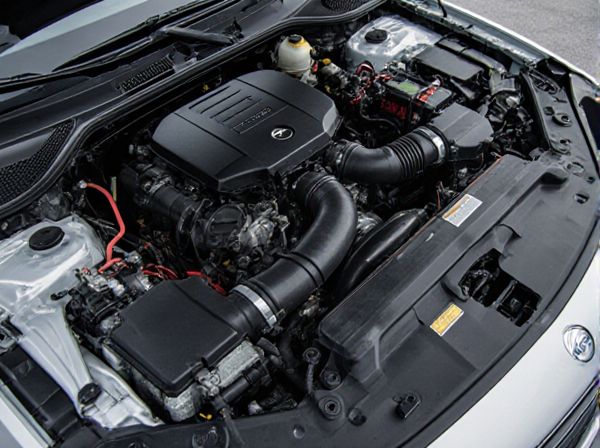
Photo illustration: Square Engine vs Oversquare Engine
Square engines have a bore and stroke of equal length, providing a balanced performance with moderate power and efficiency. Oversquare engines feature a larger bore than stroke, allowing for higher RPMs and increased power output, making them ideal for sporty or high-performance vehicles. Your choice depends on whether you prioritize engine responsiveness and top-end power or balanced efficiency and torque.
Table of Comparison
| Feature | Square Engine | Oversquare Engine |
|---|---|---|
| Bore vs Stroke | Bore = Stroke | Bore > Stroke |
| Engine Design | Balanced dimensions | Short stroke, larger bore |
| Performance | Moderate power & torque | Higher RPM, increased power output |
| Torque Characteristics | Better low to mid-range torque | Lower torque at low RPM |
| Engine Stress | Moderate piston speed | Lower piston speed at high RPM |
| Fuel Efficiency | Balanced fuel consumption | Potentially lower efficiency at low RPM |
| Common Usage | Everyday cars, balanced performance | Sports cars, high-performance engines |
Introduction to Square and Oversquare Engines
Square engines feature a bore diameter equal to the stroke length, creating a balanced design that optimizes combustion efficiency and smooth power delivery. Oversquare engines have a larger bore than stroke, allowing for bigger valves and higher engine speeds, which enhances power output and performance. The choice between square and oversquare configurations impacts engine characteristics such as torque, RPM range, and overall efficiency.
Definition of Square Engine
A Square Engine is defined by having its bore and stroke dimensions equal, which results in balanced combustion characteristics and optimized efficiency. This design typically offers a compromise between the high-revving capabilities of an Oversquare Engine, where the bore is larger than the stroke, and the torque advantages of an Undersquare Engine, where the stroke exceeds the bore. Square Engines provide a harmonious blend of power output and fuel efficiency, making them suitable for a wide range of automotive applications.
Definition of Oversquare Engine
An oversquare engine features a cylinder bore diameter larger than its stroke length, which enables higher engine speeds and improved combustion efficiency. This design reduces piston travel distance, leading to less friction and enhanced power output at elevated RPMs. In contrast, square engines have equal bore and stroke dimensions, balancing torque and power characteristics.
Key Technical Differences
Square engines have equal bore and stroke dimensions, optimizing a balance between power and torque with moderate piston speed and combustion efficiency. Oversquare engines feature a larger bore than stroke, allowing for bigger valves and higher RPM capabilities, which enhances top-end power and improved breathing. The stroke length in square engines aids in better torque delivery at lower speeds, whereas oversquare designs prioritize high-rev performance and reduced piston friction.
Performance Characteristics
Square engines, characterized by equal bore and stroke dimensions, offer a balanced compromise between power output and torque delivery, resulting in smooth engine performance across a wide RPM range. Oversquare engines, with a bore larger than the stroke, excel in high-revving capabilities, producing greater peak horsepower and faster acceleration due to reduced piston speed and enhanced airflow. This design favors performance in sports and racing applications, while the square engine remains versatile for everyday driving.
Impact on Fuel Efficiency
A square engine, with equal bore and stroke dimensions, typically achieves balanced combustion efficiency and moderate heat loss, contributing to stable fuel consumption rates. An oversquare engine, characterized by a larger bore than stroke, allows for larger valves and higher RPM capability, which can enhance power output but may lead to increased fuel consumption under heavy load due to less complete combustion at lower speeds. Optimizing fuel efficiency depends on matching engine design with operating conditions, where square engines tend to perform better in steady, low to mid-range RPMs while oversquare engines excel in high-performance scenarios with trade-offs in fuel economy.
Applications in Automotive Engineering
Square engines, where bore equals stroke, offer a balanced performance ideal for general automotive use due to their efficient combustion and moderate torque output, making them common in mid-range passenger vehicles. Oversquare engines, characterized by a larger bore than stroke, enable higher RPMs and greater power output, favoring sports cars and high-performance vehicles that require rapid acceleration and enhanced horsepower. Automotive engineers select square engines for fuel efficiency and reliability in everyday driving, while oversquare engines are chosen for performance-oriented applications demanding superior engine responsiveness and speed.
Pros and Cons Comparison
Square engines, with equal bore and stroke dimensions, offer a balance between high-revving capability and torque output, making them versatile for various performance applications. Oversquare engines, characterized by a larger bore than stroke, favor higher RPMs and improved airflow, delivering superior peak power but often at the expense of lower low-end torque. While square engines provide consistent power across a broader RPM range, oversquare engines excel in high-speed performance but may sacrifice fuel efficiency and torque in everyday driving conditions.
Suitability for Different Driving Styles
Square engines, featuring equal bore and stroke dimensions, offer a balanced power delivery and smooth performance ideal for daily commuting and moderate driving. Oversquare engines, with a larger bore than stroke, excel in high-revving capabilities, making them suitable for sporty driving styles requiring rapid acceleration and high RPM power. Drivers seeking fuel efficiency and torque for city driving tend to prefer square engines, while those favoring aggressive performance and track use benefit from oversquare engine designs.
Future Trends and Innovations
Square engines maintain an equal bore and stroke ratio, offering balanced performance and efficiency, while oversquare engines feature a larger bore than stroke, enabling higher RPMs and power output. Future trends indicate a shift towards oversquare designs in high-performance and electric hybrid vehicles to maximize combustion efficiency and meet stricter emission standards. Innovations in materials and advanced cooling systems further enhance oversquare engine durability and performance, supporting their increasing adoption in modern automotive engineering.
 caratoz.com
caratoz.com